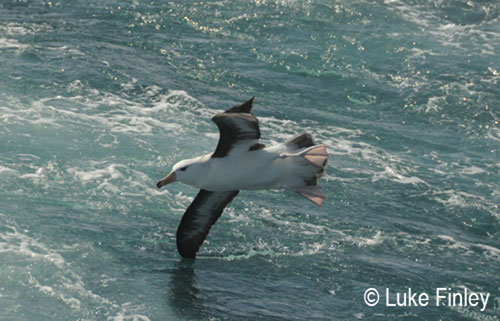Mark Hindell (School of Zoology, University of Tasmania) and colleagues have published on Areas of Ecological Significance on the Kerguelen Plateau using at-sea data from Black-browed Albatrosses.
Their paper's abstract follows:
"Avian and mammalian predators play a key role in the Kerguelen Plateau ecosystem, both with respect to structuring the marine community and its response to anthropogenic influences, such as climate change and commercial fisheries. A powerful way to determine regions of particular ecological importance is to identify Areas of Ecological Significance (AES): regions that are utilized by multiple predator species. Such concentrations of foraging activity are indicative of enhanced primary and/or secondary productivity. These are regions that require specialised management efforts, and which are of considerable importance in the development of ecological models and climate monitoring systems. This study integrates tracking and diving data from a suite of predator species collected as part of both the French and Australian Antarctic programs at Kerguelen Islands and Heard Island respectively. Tracking and/or dive data for Macaroni and King penguins, southern Elephant seals, Antarctic fur seals and Black-browed albatross were analysed. The estimated path for each animal was derived using state-space models, which also allocated each location to either "transit" or "search" behavioural modes. For diving species, dive depth data were temporally allocated along the path, providing information on three-dimensional habitat use. Areas of Ecological Significance for each species and for the combined suite of predators were identified using Kernel Density analysis. The role of bathymetry, ocean circulation and other environmental factors underlying the AES were established using deterministic models, which can be used to predict predator foraging habitats across the entire plateau."
Reference:
Hindell, M.A., Bost, C.A., Charrassin, J.B., Gales, N., Lea, M.A., Goldsworthy, S., Page, B., Robertson, G., Wienecke, W., O'Toole, M. & Guinet, C. 2011. Foraging habitats of top predators, and areas of ecological significance, on the Kerguelen Plateau. In: Duhamel, G. & Welsford, D. (Eds). The Kerguelen Plateau: Marine Ecosystem and Fisheries. Société d'Ichtyologie 2011: 203-215.

Juvenile Black-browed Albatross at sea
Click here for an earlier related news story.
John Cooper, ACAP Information Officer, 25 September 2011

 English
English  Français
Français  Español
Español